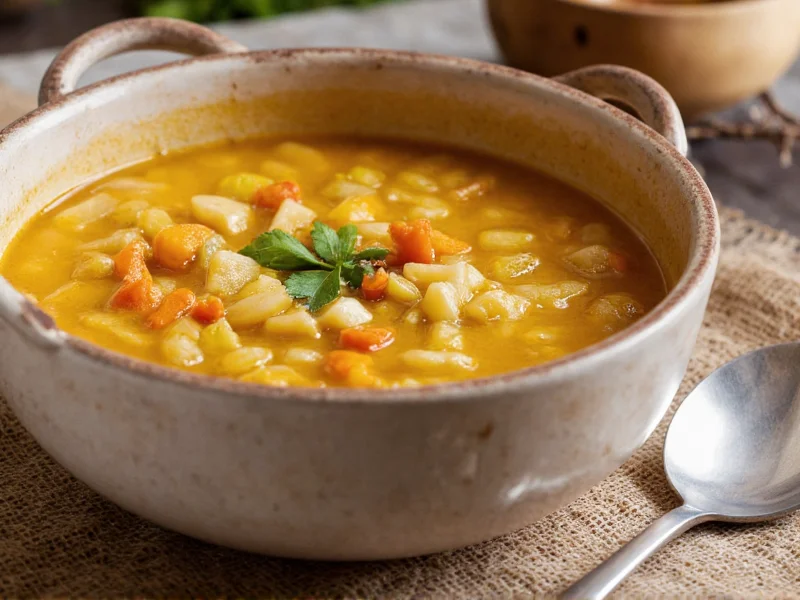Turnip soup transforms humble root vegetables into a sophisticated culinary experience that has sustained cultures worldwide for centuries. Beyond its reputation as peasant food during difficult historical periods, modern chefs have rediscovered turnip soup's remarkable versatility and nutritional profile. This guide explores the science behind perfect turnip soup preparation, addressing common pitfalls that lead to bitter or watery results while highlighting techniques professional chefs use to maximize flavor development.
The Historical Journey of Turnip Soup
Turnips have nourished civilizations since ancient times, with archaeological evidence showing their cultivation in Northern Europe as early as 2000 BCE. Scottish neeps (mashed turnips) traditionally accompany haggis, while Scandinavian kålrabisteppe incorporates turnips with rutabagas. French potée provençale features turnips alongside smoked meats, and Eastern European cultures developed hearty borscht variations using turnips when beets were unavailable. Understanding these cultural roots helps modern cooks appreciate turnip soup's evolution from survival food to gourmet staple.
Nutritional Science Behind Turnip Soup
Turnips provide exceptional nutritional value that intensifies when cooked into soup. A single cup of cooked turnip cubes contains:
| Nutrient | Amount per Cup | Daily Value % |
|---|---|---|
| Vitamin C | 20mg | 22% |
| Dietary Fiber | 2.3g | 9% |
| Potassium | 297mg | 6% |
| Vitamin K | 0.3mcg | 3% |
| Folate | 16mcg | 4% |
Research published in the Journal of Food Science demonstrates that cooking turnips increases their antioxidant bioavailability by up to 30% compared to raw consumption. The glucosinolates in turnips convert to beneficial compounds during cooking that support liver detoxification pathways. Unlike starchy alternatives, turnip soup maintains a low glycemic index (35) making it suitable for blood sugar management.
Essential Ingredients for Perfect Turnip Soup
Selecting quality components determines your soup's success. Follow these professional guidelines:
Turnip Selection Criteria
Choose small to medium turnips (2-3 inches diameter) with firm, smooth skin. Larger turnips often develop woody cores and increased bitterness. Purple-top varieties offer the best flavor balance for soup. Store turnips in the refrigerator's crisper drawer for up to two weeks, but remove greens immediately as they draw moisture from the root.
Broth Selection Science
Homemade vegetable broth provides superior flavor control, but when using store-bought options, check sodium levels carefully. Professional chefs recommend low-sodium broths with at least 3g of protein per cup, indicating proper collagen extraction. For non-vegetarian versions, chicken or bone broth adds depth through gelatin content that creates a luxurious mouthfeel.
Step-by-Step Preparation Method
Follow this chef-developed technique for optimal flavor development:
- Prep ingredients: Peel and dice 1.5 lbs turnips into 1/2-inch cubes. Finely chop 1 medium onion, 2 celery stalks, and 2 carrots. Mince 3 garlic cloves.
- Sweat aromatics: In a 4-quart pot, heat 2 tbsp olive oil over medium heat. Add onions, celery, and carrots with pinch of salt. Cook 8-10 minutes until translucent but not browned.
- Build flavor foundation: Add garlic and 1 tsp fresh thyme, cooking 1 minute until fragrant. Deglaze with 1/4 cup dry white wine, scraping browned bits.
- Add turnips and liquid: Incorporate turnips and 4 cups broth. Bring to gentle simmer (not boil) to prevent bitterness.
- Controlled cooking: Simmer covered 25-30 minutes until turnips pierce easily with fork. Overcooking causes texture breakdown and flavor loss.
- Final seasoning: Stir in 1 tbsp lemon juice and adjust salt. For creamy version, blend 2 cups soup and return to pot with 1/2 cup coconut milk.
Avoiding Common Turnip Soup Mistakes
Professional chefs identify these critical errors that ruin turnip soup:
- Boiling instead of simmering: High heat extracts bitter compounds from turnips. Maintain temperature at 180-200°F (82-93°C).
- Adding salt too early: Salt vegetables during sweating stage, but delay additional salt until final seasoning to prevent over-reduction.
- Using old turnips: Stale turnips develop hollow centers that impart unpleasant flavors. Check for firmness by squeezing gently.
- Over-blending: Blending hot soup creates pressure that can cause burns. Cool slightly and fill blender only halfway.
Regional Variations Worth Trying
Explore these authentic adaptations that showcase turnip soup's versatility:
Scandinavian Creamy Turnip Soup
Add 1 peeled and diced tart apple with the turnips. Finish with 1/2 cup heavy cream and fresh dill. Serve with crisp rye bread.
Mediterranean Turnip and White Bean Soup
Add 1 can rinsed cannellini beans with the broth. Finish with lemon zest and chopped rosemary. Perfect for high-protein vegetarian meals.
Asian-Inspired Turnip Miso Soup
Replace half the broth with dashi. Add 3 tbsp white miso paste after cooking. Garnish with scallions and toasted sesame oil.
Serving and Storage Guidelines
Maximize your turnip soup experience with these professional tips:
- Temperature matters: Serve between 160-170°F (71-77°C) to optimize flavor perception
- Garnish strategically: Add fresh herbs and a drizzle of quality oil just before serving to preserve volatile aromatics
- Storage science: Cool completely before refrigerating in airtight containers. Properly stored soup maintains quality for 4 days
- Freezing technique: Freeze without dairy additions. Thaw overnight in refrigerator and add cream when reheating
- Reheating method: Warm gently over medium-low heat, stirring occasionally. Avoid boiling which degrades texture
Seasonal Pairing Recommendations
Turnip soup's flavor profile complements different ingredients throughout the year:
- Spring: Pair with fresh peas and mint for bright, clean flavors
- Summer: Serve chilled as a vichyssoise-style soup with chive blossoms
- Autumn: Add roasted squash and sage for earthy warmth
- Winter: Incorporate smoked paprika and black pepper for comforting heat











 浙公网安备
33010002000092号
浙公网安备
33010002000092号 浙B2-20120091-4
浙B2-20120091-4